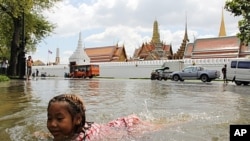Thailand’s flood waters have reached Bangkok’s Grand Palace, a historical site that once housed Thai kings, and is now a major tourist attraction.
Thousands are leaving Bangkok as the country's worst floods in decades inundate parts of the capital.
Bangkok’s Chao Phraya River spilled over into historical riverside buildings Friday, including the Grand Palace. At the former home of Thailand’s monarchies, soldiers scrambled to pump out ankle-deep water.
When the tides receded, the landmarks were dry and open. But after days of tourists and locals fleeing the Thai capital, the normally crowded historic district was calm.
Two tourists from Venice traveling together who gave only their first names, David and Eduardo, said they frequently come to Bangkok for vacation.
But they lamented that some places were closed due to the flooding.
DAVID: "I want to go with the boat today but it’s not possible because the service is closed."
EDUARDO: "It’s not possible because the market is closed!"
DAVID: "I go to the hotel. I sleep.”
The flooding has interrupted supermarket supply chains. Residents stocking up on supplies have emptied Bangkok’s shelves of essentials.
Some grocery stores are now rationing food and water as anxiety grows over more severe flooding expected this weekend.
Nineteen-year-old James from Britain plans to travel to northern Thailand with a friend. He says he is not very worried about the floods, but has noticed the empty store shelves.
“It’s very hard to get bottled water though. There’s not a lot of bottled water around, so that’s a problem. But not much else,” James says.
With riverside neighborhoods now routinely flooding during high tide, there is concern that even higher tides in the coming days and more floodwaters from the north could worsen the situation.
Thailand’s central plains have been inundated for months, closing several industrial parks, crippling manufacturing, and killing hundreds.
Foreign governments, including the United States, have warned citizens against unessential travel due to the transportation difficulties and shortages of food.











